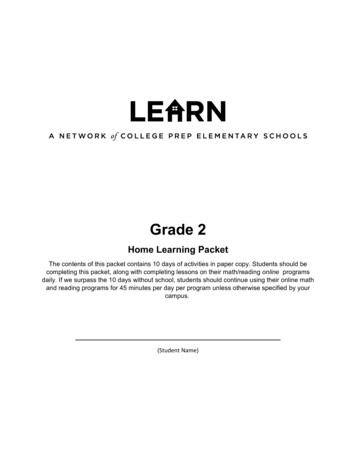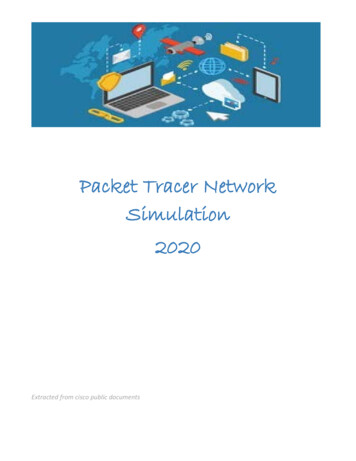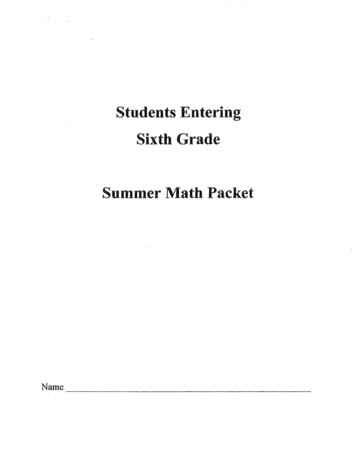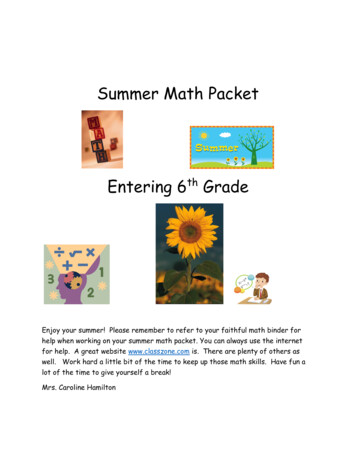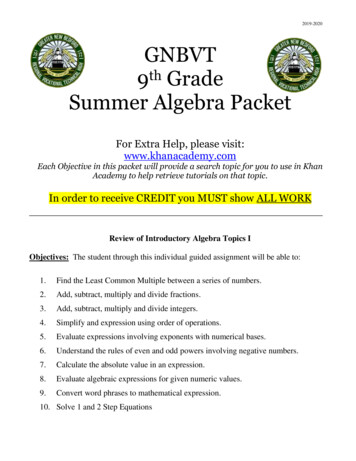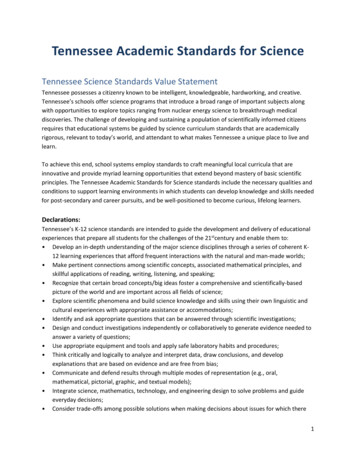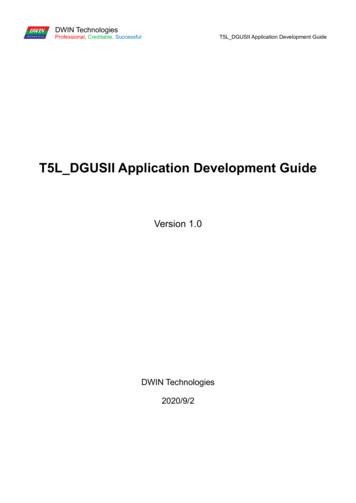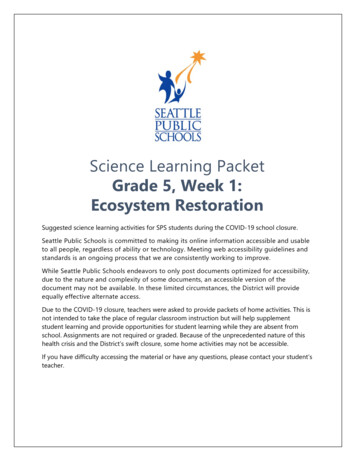
Transcription
Science Learning PacketGrade 5, Week 1:Ecosystem RestorationSuggested science learning activities for SPS students during the COVID-19 school closure.Seattle Public Schools is committed to making its online information accessible and usableto all people, regardless of ability or technology. Meeting web accessibility guidelines andstandards is an ongoing process that we are consistently working to improve.While Seattle Public Schools endeavors to only post documents optimized for accessibility,due to the nature and complexity of some documents, an accessible version of thedocument may not be available. In these limited circumstances, the District will provideequally effective alternate access.Due to the COVID-19 closure, teachers were asked to provide packets of home activities. This isnot intended to take the place of regular classroom instruction but will help supplementstudent learning and provide opportunities for student learning while they are absent fromschool. Assignments are not required or graded. Because of the unprecedented nature of thishealth crisis and the District’s swift closure, some home activities may not be accessible.If you have difficulty accessing the material or have any questions, please contact your student’steacher.
Elementary Science Learning ActivityMaterials to accompany Lessons 1-3Grade 5Ecosystem Restoration:Matter and Energy in a Rain ForestInvestigation Packet
Hello Families,We have been thinking of you and hope you and your family are well and safe during this time. Being at homeis different than HAVING to be at home and we wanted to offer you instructional opportunities. If we were atschool, we’d be in a 5th grade classroom beginning a study on ecosystems but since we’re all at home, you arewelcome to invite family members to join you in these series of lessons. We all know learning is more funwhen we share our ideas and learn from one another.Amplify Science is the science program we have been using in some of our classroom this year. It is ourofficially adopted instructional material for science.A collaboration between the science education experts at University of California Berkeley's Lawrence Hall ofScience and the instructional technology experts at Amplify, Amplify Science was built to empower students toinvestigate, talk, read, write, think, and argue like real scientists and engineers through investigations of realworld problems and scientific phenomena.While Amplify Science lessons are designed to be done in the classroom with peers, there are some activitiesthat students can complete at home with your support. To make it as easy as possible to do these activities athome, I am providing you with the following resources:Lesson Overview. The activities I am sending are all part of larger lessons. The full lesson would bevery difficult to do at home, but I have provided the lesson overview so that you have some context forthe purpose of the individual activity. Packet for the specific activity in the lesson. This will provide step-by-step instructions if you wishto guide your students through the activity. Please note, however, that the instructions will only beincluded for the specific activity I have assigned. Not the whole lesson. Use the space provided to drawand/or write your ideas, you can also include what other family members contribute. Videos to use with the packet. The Seattle Public Schools’ Science Department created this packetto be used with or without the video. We created a series of videos you can access either online orthrough Seattle’s Public television programming on SPS TV (local channel 26), social media (Facebook and Instagram: @SeattlePublicSchools, Twitter: @SeaPubSchools), and our SPSTV YouTube channel.KOMONews.com will also host on-demand videos under the tab “Lesson Plan” and broadcast onchannel KOMO 4.3. These supplemental learning videos feature short segments supporting a variety ofsubjects and grade levels. All videos will be close captioned on YouTube.Should you have the option to use the internet, these are the device requirements.However, you can complete these lessons WITHOUT electronic devices! Desktops and Laptops (Windows 7 , Mac OS 10.11 ) - Suggested browsers: Chrome & SafariChromebooks - Suggested browser: ChromeiPads that support iOS11.3 (iPad5 ) - Suggested browser: SafariSincerely,Ms. Benita and Seattle Public Schools Science Department
This packet has content materials for the first three lessons in Chapter 1 of Ecosystem RestorationChapter 1 Lesson1.11.21.3English/SpanishGlossaryPages in the Packet4-89-1415-1718-19If you do have a computer and internet access, here is how to obtain access to the availableAmplify online resources For the simulation, navigate ration/#/For the book, navigate /#page 1Select “Log In with Amplify” buttonEnter teacher-provided usernameand password (see below)Username: s.seattle1@tryamplify.netPassword: SeattleSci2020
Lesson 1.1 Introduction: Let us begin with what we know:What do you know about ecosystems?Use the space to write about what you alreadyknow. You can also write questions you might haveabout ecosystems.This is not a test! If you are stuck on the question, then look outside and write down the things you see in theecosystem that is what you are looking at when you look outside! And the longer you look, the more you’llsee.4
5
We can think of ecosystems as places where animals and plants live together in their environment.There are many different kinds of ecosystems, and different types of living things live in differentecosystems. Let’s think about a few examples.What living things do you think we would find in a rainforest ecosystem? What might those living things need togrow?Rain forest in Border Ranges National Parkin AustraliaWhat living things do you think we would find in a desertecosystem? What might those living things need to grow?Desert in Signal Peak, Arizona, UnitedStates6
In these lessons, we will gather evidenceto answer this question. It’s okay if youdon’t understand all the words in thisquestion yet—you will learn about them inthis unit. The question means that we willbe investigating how living things in anecosystem grow and what they need to behealthy.Families, there is no need for your child tofully understand these ideas yet. Theselessons build on each other and help yourchild “grow” their learning andunderstanding.This unit of study includes a Simulation. A simulation is a computer program. Ecologists and other scientistsoften make and use simulations to study things they cannot measure directly. Simulations also allow scientiststo speed up time to study outcomes, or events that happened in the past, like when dinosaurs roamed theEarth. Scientists also use simulations to study our solar system and the galaxy because we cannot study thesein a lab nor go out to such places like distance planets or black holes.If you have access to a computer and the internet, then do visit the sim and think about how this sim like anecosystem. Use this space below for your observations and questions.7
Thank you for spending time with me and thinking about ecosystems. We have covered a lot! We first thoughtabout these two different ecosystems. You can also look out your window and ask the very same questionabout the ecosystem where you live. What living things do you think we would find in your ecosystem? Whatmight those living things need to grow? We also learned about how ecologists study ecosystems and in ournext lesson, we’ll take on the role of an ecologist and look at a problem happening in a Costa Rican rainforest.Here is some space for you to write about your ecosystem.8
Lesson 1.2: Today, we will learn about a problem with the ecosystem inCosta Rica.We can see from this map that Costa Rica is acountry in Central America. Is your family fromCentral America? Do you know someone from CostaRica?These are some of the living thingsfound in the Costa Rican rain forest.We will take on the role of ecologistsworking for Natural ResourcesRescue, a group that works to protectand save fragile ecosystems around theworld. Let’s take a closer look at the areawe are studying.9
The first photo shows the study area 10 years ago. It used to be a healthy rain forest. Then, cattle ranchersburned down the rain forest so they could use the land as grazing area for their cows. Have you heard of thishappening before? What are positive and negative consequences to these actions?The second photo shows the same area today. A few years ago, the cattle ranchers left and took the cowswith them. They planted trees so the area would become a rain forest again. The plan was to reforest thisarea so it could become part of the ecosystem again.Our group, the Natural Resources Rescue, worked with volunteers to replant the area. They brought in youngcecropia trees and other important rain forest plants and planted them. However, the area was not recoveringlike we had expected it to; we looked at a nearby area to compare. Here is what we found:JaguarsThree-toed slothsCecropia treesOrganism count in our study area100 sq km (38.6 sq miles)116188Organism count in nearby healthy area100 sq km (38.6 sq miles)428596What do you notice about the information in the above table?We learned more:JaguarsThree-toed slothsAverage weight of adult animals in ourstudy area168 kg (370.4 lbs)4.42 kg (9.75 lbs)Average weight of adult animals innearby healthy area205 kg (452 lbs)4.76 kg (10.5 lbs)What does this information tell you about our study area and the nearby, healthier one?Why aren’t the jaguars and sloths growing and thriving? What do they need from their ecosystem? Why arethey not getting what they need? Our task will be to find out what is happening in this reforested area.Before we do that, we need practice doing what ecologists do by observing and discussing scientificdrawings of ecosystems. Observe and discuss the illustrations with an available family member. Thenrecord your own ideas by adding labels, writing notes, or both. You can do this on your own as well.10
Pond EcosystemObservations: 2018 The Regents of the University of California. All rights reserved. Permission granted to photocopy for classroom use.11
Desert EcosystemObservations: 2018 The Regents of the University of California. All rights reserved. Permission granted to photocopy for classroom use.12
Rain Forest EcosystemObservations: 2018 The Regents of the University of California. All rights reserved. Permission granted to photocopy for classroom use.13
After you have completed the 3 pages, look back and think about these questions: What did you observe ineach of the ecosystems? How were the ecosystems similar, and how were they different from each otherand from the one outside your window?We will read a book called, Matter Makes it All Up, to help us think about the jaguars and sloths. While weread, we want to think about how is it that animals grow, this will help us to answer the bigger question aboutour study site.Notes that on page 5, it says that everything in an ecosystem is made of billions and trillions of atoms andmolecules that are too small to see. As you read pages 6–11, think about the question: How do animalsgrow? Use the photos, diagrams, and captions to help you understand.Accessing the book online Navigate /#page 1Select “Log In with Amplify” buttonEnter teacher-provided usernameand password (see below)Username: s.seattle1@tryamplify.netPassword: SeattleSci2020If you do not have access to a computer and/or the internet, I will provide you with the information you needfrom this book.14
Lesson 1.3: Let’s review some important parts of the bookBased on this page, how would youdescribe the matter found in whereyou are right now?Add this to your description: Matter isthe stuff things are made of! We’ll talkmore about this stuff.This is more from page 5.And pages 6 & 7: What does itreally mean to say that an animalis made of matter? If you couldlook inside the body of analligator, you would see muscles,bones, blood, and different bodysystems. All of the parts of analligator are made of matter. Forexample, let’s zoom-in on amuscle. The muscle is made up ofsmaller parts. Those parts aremade up of even smaller parts,which are made up of molecules.Those molecules are made up atatoms. It’s all matter!15
What are some of the things mentioned in the book that are made of matter (that stuff)? And what is alsomatter that we cannot see? Return to the text, that’s why it is there? Record them here.Keep in mind that everything is made of matter. Matter is made of molecules. You will need to following pagesto complete the next activity.Page 8: A full-grown alligator may weigh 360 kilograms (800 pounds). That’s a lot of matter! Where does it allcome from? How does an alligator grow to be so big? Alligators andother animals never stop growing. Even an adult animal that hasstopped getting bigger keeps growing new skin and blood. If ananimal gets wounded our breaks a one, its body can grow to repairthe damaged parts.Page 9: All that new bone, muscle,blood, and skin doesn’t just appear from nothing. Since an animal is made ofmatter, when it grows it needs to add more matter to its bones, muscles, andother parts. That’s how animals grow.The new matter needed for growth comes from what an animal eats. Food salso made of matter. When an animal eats food, it is eating billions andbillions of atoms and molecules. These atoms and molecules are all matterthat the animal uses to grow. Inside the animal’s body, the food moleculesare broken down and used to build new molecules that make up bone, blood,muscle, skin, and other body parts. Page 10Not all the matter that an animal eats gets added to theanimal’s body. Some of the matter isn’t used by theanimal. This matter ends up as different kinds of waste,including droppings. More important, the animal usessome of the food matter to get energy. (Animals needenergy to move and do all of the things animals do.)When an animal uses matter to get energy, that matteris changed and released as gases into the air. (p. 11)We will use the next page in the packet to synthesizeinformation from the book. When we are reading ascience text, it can be helpful to think about howdifferent ideas in a book are connected. This canhelp us to understand what we have read and connectit to science ideas we are learning. Connecting differentideas this way is called synthesizing. Let’s do the firstone together.Are you thinking about a new understanding thatrelates to the investigation question? How do animals grow? Are you putting ideas from different parts ofthe text together?16
Synthesizing Ideas About How Animals Grow1. Reread pages 8–11of Matter Makes It All Up and think about the questionbelow.2. Record information in the boxes that could help answer the question.3. Connect ideas together to come up with a new understanding that answers thequestion.4. Record the new understanding in the box below the arrow. Question:How do animals grow?Page: 9 Since an animal is made of matter, when it grows it needsto add more matter to its bones, muscles, and other parts.Page:Page:New understanding: 2018 The Regents of the University of California. All rights reserved. Permission granted to photocopy for classroom use.17
Ecosystem Restoration Glossaryargument: the use of evidence to say why one idea is the bestargumento: el uso de evidencia para decir por qué una idea es la mejorclaim: a proposed answer to a questionafirmación: una respuesta propuesta para una preguntadata: observations or measurements recorded in an investigationdatos: observaciones o mediciones apuntadas en una investigacióndecomposer: an organism that breaks down droppings or dead organismsdescomponedor: un organismo que desintegra las heces o los organismosmuertosecologist: a scientist who studies ecosystemsecologista: un/a científico/a que estudia los ecosistemasecosystem: a community of organisms together with its environmentecosistema: una comunidad de organismos junto con su ambienteenergy: the ability to make things move or changeenergía: la capacidad de hacer que las cosas se muevan o cambienenvironment: all the living and nonliving things in an areaambiente: todo (viviente y no viviente) lo que hay en un áreaevidence: information that supports an answer to a questionevidencia: información que respalda una respuesta a una preguntafood web: a diagram that shows what eats what in an ecosystemred alimentaria: un diagrama que muestra qué come qué en un ecosistemamatter: the stuff that things are made ofmateria: lo que constituye las cosas18
Ecosystem Restoration Glossary (continued)model: something scientists make to answer questions about the real worldmodelo: algo que los científicos crean para responder preguntas sobre elmundo realmolecule: a group of atoms joined together in a particular waymolécula: un grupo de átomos unidos de una manera particularnutrient: something taken in by plants and animals that helps them grownutriente: algo que toman dentro las plantas y los animales y que los ayuda acrecerobserve: to use any of the five senses to gather information aboutsomethingobservar: usar cualquiera de los cinco sentidos para recolectar informaciónacerca de algoorganism: a living thing, such as a plant or an animalorganismo: un ser viviente, por ejemplo, una planta o un animalrestoration: the process of returning something to its original condition byfixing or repairing itrestauración: el proceso de regresar algo a su estado original al arreglarlo orepararlosoil: a mixture of rocks, water, air, parts of dead organisms, and tinyliving organismssuelo: una mezcla de rocas, agua, aire, partes de organismos muertos yorganismos vivientes diminutossynthesize: to put together multiple pieces of information in order tounderstand somethingsintetizar: juntar varias piezas de información con el fin de entender algo19
Science Learning Packet Grade 5, Week 1: . If you are stuck on the question, then look outside and write down the things you see in the ecosystem that is what you are looking at when you look outside! And the longer you look


